|
|
|
Sort Order |
|
|
|
Items / Page
|
|
|
|
|
|
|
| Srl | Item |
| 1 |
ID:
152969
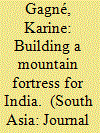

|
|
|
|
|
| Summary/Abstract |
This article examines the relationship between affect and the state in post-colonial India, foregrounding sympathy as a feeling that arises from the embodied encounters and interactions between the state and a local population through state-building in the Himalayas. It establishes the emergence of sympathy in the materiality of the Himalayas and in the historical conjuncture of the passage to Indian nationhood in Ladakh, which was marked by the mobilisation of the local population in the defence of the territory of India amid the first Indo-Pakistani war (1947–48). This article argues that sympathy, in leading the state to reimagine the population of Ladakh, is integral to the reconfiguration of the region into a border area and to the rethinking of the sovereignty of the Indian state at its Himalayan frontier.
|
|
|
|
|
|
|
|
|
|
|
|
|
|
|
|
| 2 |
ID:
148021


|
|
|
|
|
| Summary/Abstract |
In the imaginations of many, war in British India had its focus on the North-West Frontier and was fought against the tribes of that region. However, British thinking about Indian defence involving Afghanistan underwent tremendous change over the period under consideration. British plans to meet a Russian invasion on the Kabul-Kandahar Line in 1904 resembled those of any other Nineteenth Century Imperial campaign, with numbers of infantry and cavalry still being thought of and referred to as bayonets and sabres. Twenty years later, heavily influenced by the experiences of the Great War in the region and the Third Afghan War and associated operations, the calculus was different with logistics changed by motor vehicles and the introduction of what today are referred to as force multipliers, such as aeroplanes and machine guns. It was over this period that warfare as fought and conceptualised by men like Napoleon gave way to modern practices familiar to us today.
|
|
|
|
|
|
|
|
|
|
|
|
|
|
|
|
| 3 |
ID:
107953
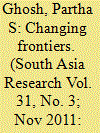

|
|
|
|
|
| Publication |
2011.
|
| Summary/Abstract |
This article focuses on patterns of the peopling of East Bengal from the seventeenth to the twentieth centuries and analyses the dynamics of this process in terms of the migrants' religious, social and political values. In this process, a number of boundaries were crossed, which South Asian Area Studies experts are still struggling to understand. Exploring this phenomenon of changing frontiers from a comparative historical perspective, the westward expansion of America during almost the same phase is analysed, showing similarities between the two phenomena, but also distinct dissimilarities. In Bengal, unlike America, there was no major violence involved and the migrations into Bengal were not at the cost of the native inhabitants, as largely happened in America. Arguing that, in grappling with the present Bangladesh-India relations, such historical knowledge is necessary, the article calls for greater interactions between intellectuals from both sides, which may be called Track III dialogue.
|
|
|
|
|
|
|
|
|
|
|
|
|
|
|
|
| 4 |
ID:
101286


|
|
|
|
|
| Publication |
2010.
|
| Summary/Abstract |
By advancing what I am calling the new frontier of the United States and Mexico as central in the formation of subjectivities, this article foregrounds two contemporary figures: 'cholos' and the 'chuacutentaros.' The former is how a particular group of youths, who called themselves Barrio Libre or the Free 'Hood, self-identified and the term is often common shorthand for 'gang' in much of the Americas. The term speaks to the premiere figure of an anxiety about unchecked, undocumented, and criminalized racial and cultural flows in the Americas. The cholos of Barrio Libre preyed on 'chuacutentaros,' the provincial 'hick' of an increasingly urbanizing, migrating Mexico. 'Chuacutentaros' has also become a term for the alien bodies that pass through daily projects of state sovereignty at the margins of two states, specifically United States and Mexican intensifying militarized policings and their dramatic abandonments. In this article, I situate these practices within the history of largely unacknowledged racisms in Mexico, tied to projects of mestizaje.
|
|
|
|
|
|
|
|
|
|
|
|
|
|
|
|
| 5 |
ID:
185100
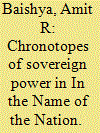

|
|
|
|
|
| Summary/Abstract |
This article is part of a Book Forum review of Sanjib Baruah’s book In the Name of the Nation: India and its Northeast (2020). The Book Forum consists of individual commentaries on this text by five interested scholars, followed by a response by the author. The article may be read individually or alongside the other contributions to the Forum, which together constitute a comprehensive discussion of the themes and arguments in the book.
|
|
|
|
|
|
|
|
|
|
|
|
|
|
|
|
| 6 |
ID:
112742
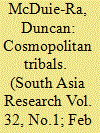

|
|
|
|
|
| Publication |
2012.
|
| Summary/Abstract |
Based on fieldwork, this article examines various aspects of tribal migration from the Northeast frontier of India to Delhi, a phenomenon which increased rapidly in the last half decade or so. This offers insights into four important interlinked processes. First, such migration indicates significant changes taking place in the Northeast itself. While many migrants leave the region to escape conflict, many more simply seek to find work, pursue education and fulfil changing aspirations. Second, tribal migration to Delhi reveals the ways in which the city itself has been changing. While tribal migrants search out employment opportunities in neoliberal capitalist spaces, employers in such spaces have specific reasons to desire tribal labour, particularly in shopping malls and call centres. Third, tribal migrants encounter racism and discrimination in Delhi and their experiences reveal how racial issues function and are debated today within India. Fourth, tribal migrants themselves embody the dramatic discord between the ways tribals see themselves and the ways they are perceived in India.
|
|
|
|
|
|
|
|
|
|
|
|
|
|
|
|
| 7 |
ID:
154387
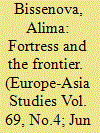

|
|
|
|
|
| Summary/Abstract |
As the seat of the Kazakh government and a booming city since 1998, Astana has attracted hundreds of thousands of migrants. As a cultural and financial capital, Almaty has also continued to boom, drawing comparable numbers of migrants from different regions of Kazakhstan. However, varying historical trajectories and historically constructed notions of the urban and rural, as articulated by the cultural elites and policy-makers, as well as different preparedness of the government for migration flows in the 1990s and the 2000s in Almaty and Astana respectively, have resulted in quite diverse attitudes toward mobility and different perceptions about how urban order should be achieved.
|
|
|
|
|
|
|
|
|
|
|
|
|
|
|
|
| 8 |
ID:
152971
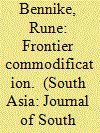

|
|
|
|
|
| Summary/Abstract |
In the contemporary global imagination, Darjeeling typically figures on two accounts: as a unique tourism site replete with colonial heritage and picturesque nature, and as the productive origin for some of the world's most exclusive teas. In this commodified and consumable form, Darjeeling is part of a wide array of frontier places that are increasingly incorporated into the circuits of global capitalism. In the present article, I argue that Darjeeling is in fact an early and emblematic example of such incorporation. By connecting emerging literature on the pre-colonial history of the area with a critical reading of colonial sources, I trace the shifts and erasures that enabled Darjeeling's commodification—a process that involved its transformation from a ‘wild’ Himalayan frontier into a speculative wasteland and, ultimately, into a picturesque and productive ‘summer place’. Reading through a range of material and representational interventions, I uncover the particular assemblage of government and capital that enabled this transformation and highlight its potential resonances with contemporary cases of frontier commodification in South Asia and beyond.
|
|
|
|
|
|
|
|
|
|
|
|
|
|
|
|
| 9 |
ID:
192665


|
|
|
|
|
| Summary/Abstract |
This study explores the interface of the Grand Ethiopian Renaissance Dam (GERD), a high-modernist hydraulic scheme, with the protracted frontier conflict in Metekel Zone of Benishangul Gumuz Regional State. Without downplaying the national technocratic ambitions that it invokes, based on fieldwork conducted in 2022, the study witnessed as the dam’s presence in Metekel has escalated the perennial state-local skirmishes, rekindled inter-group hostilities, and ultimately trans-nationalized the frontier mayhem in the area. Such impacts of the dam were rooted in the state’s long-held frontier imagination and coercive relocation program through which hegemonic high-modernist narratives contested locals’ lived experiences. Differential local impacts of the dam, its role in mounting competing territorialities, and the concomitance of the trans-national feud with local discords were also equally influencing. However, the interface between the GERD and frontier struggles in Metekel was broadly shaped by the frontier’s history and national governance policies. In revealing so, the study provides insights that complement debates about frontier dynamics and struggles in Ethiopia and Africa, which tend to concentrate on tensions related to land transfer for private investors. Indeed, frontier struggles seem too complex: one must interrogate multiple actors, the complex history, and a broader range of issues with local, national, and regional dimensions.
|
|
|
|
|
|
|
|
|
|
|
|
|
|
|
|
| 10 |
ID:
179345


|
|
|
|
|
| Summary/Abstract |
This is a review article of J. B. Kelly's three-volume work Desert Dispute: The Diplomacy of Boundary-Making in South-Eastern Arabia, ed. Saul B. Kelly (Gerlach Press, Berlin, 2018 and 2020). It covers in detail the diplomatic background to the development of the frontiers of Saudi Arabia, the UAE, Qatar and Oman, from 1911 to the 1990s, including the involvement of tribal shaikhs, Ibn Saud, the Ottomans, the British and American governments, and also the oil companies prospecting in the region.
|
|
|
|
|
|
|
|
|
|
|
|
|
|
|
|
| 11 |
ID:
148494
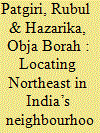

|
|
|
|
|
| Summary/Abstract |
India’s neighbourhood policy seems to be devoid of any strategy to integrate national interests with the concerns of border regions like Northeast India. India’s security-centric approach prevented a cooperative relationship from emerging with its neighbours, while a deeper and intense engagement with them would have benefitted India and helped solve many of the problems that Northeast India is facing today. However, the recent move by India under the Act East Policy to cultivate a much closer relationship with its eastern neighbours is full of possibilities to make India’s neighbourhood policy more accommodative and sensitive towards the needs of Northeast India. In the light of this, the proposed article intends to examine the nature of India’s neighbourhood policy, to assess its implications for the Northeast and finally, to examine whether the recent transnational engagements can initiate development of the Northeast by relieving it from its peripheral and landlocked status.
|
|
|
|
|
|
|
|
|
|
|
|
|
|
|
|
| 12 |
ID:
192622
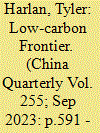

|
|
|
|
|
| Summary/Abstract |
China's west has long been framed as an undeveloped frontier, set apart by poverty and a resource-based economy. Since the 2000s, however, utility-scale renewable energy infrastructure has expanded rapidly in western China, promising local economic benefits tied to national low-carbon transition. This paper contends that these benefits have been precarious and unevenly distributed. I argue that utility-scale renewable energy has remade western China as a “low-carbon frontier,” a resource-rich region that generates low-carbon value for the national green economy. I highlight three features of low-carbon frontiers: they are constructed as spaces of exploitable low-carbon resources, creating an investment boom; they are enclosed through new land arrangements and infrastructure construction, rapidly and with little coordination; and they are reliant on external markets and policy decisions, entrenching dependency. These conditions make it difficult for frontier regions to capture sustained economic development benefits from the boom in the absence of persistent central state supports. I analyse these features by comparing two sets of technologies with similar, but ultimately diverging, trajectories: small and large hydropower in China's south-west, and solar and wind in the north-west.
|
|
|
|
|
|
|
|
|
|
|
|
|
|
|
|
| 13 |
ID:
147649
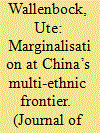

|
|
|
|
|
| Summary/Abstract |
China consists of a mosaic of many territorial ethnic groups whose historic homelands have been incorporated into the modern Chinese state, a process by which the respective populations transformed from a “sovereign or semi-sovereign people” (Bulag 2002: 9) on China’s periphery into “minority nationalities” (少数民族, shaoshu minzu). In 1950 Mao Zedong initiated the “Ethnic Classification Project” whose effect has been the marginalisation of the minority nationalities. In this paper, I explore the marginalisation of the Mongol population of contemporary Henan Mongolian Autonomous County within the Huangnan Tibetan Autonomous Prefecture in southeastern Qinghai Province. By seeking to understand how Henan Mongols deal with their socio-political and demographic marginal status, the aim of this article is to shed light on how they utilise their marginal position, and how they centralise themselves as an independent party interacting with the civilising missions of China and Tibet.
|
|
|
|
|
|
|
|
|
|
|
|
|
|
|
|
| 14 |
ID:
174155
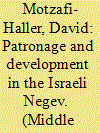

|
|
|
|
|
| Summary/Abstract |
The article focuses on the early stages of the colonization of the Israeli Negev during the 1950s. It reconstructs the early stages of the settlement of Yeruham from the perspective of one local administrator, Shlomo Tamir, who managed the settlement for a one-year period, 1952–1953. Conceptualizing Tamir’s role as that of a mediator, it draws attention to the forming political structure of patronage and clientelism on the local level and the concomitant changes in the ‘big-man’ networks of pre-state elite networks as they expanded into Israel’s southern frontier. A micro historical analysis focused on Tamir’s deputies furnishes a discussion on the social make-up of the Israeli frontier, comprising of a typical frontier mixture of fortune seekers, opportunity hunters, semi-indentured laborers and upwardly mobile colonists.
|
|
|
|
|
|
|
|
|
|
|
|
|
|
|
|
| 15 |
ID:
079928
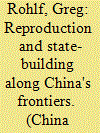

|
|
|
|
|
| Publication |
2007.
|
| Summary/Abstract |
This article analyzes population resettlement to western China during contemporary times within a historical framework that emphasizes gender. During the 1950s most relocatees to Qinghai were men, following the historical pattern set by Qing policies. Empirical data also show that the PRC government explicitly recruited women for relocation to border and remote areas. Women were moved to western regions as somewhat gender-neutral workers and also to serve in their traditional roles as wives and mothers. In both roles, women were a crucial component in state-building policies in border and remote areas. In fact, because sovereignty could not be permanently established without a naturally reproducing population, one can argue that reproduction was, and is, a basic component of state-building-an assertion that gets little attention in analyses of social and political change in border regions. This article describes the consolidation phase of territorial expansion as a feminine or yin process that relied upon incremental, organic growth, or "soft" assertions of power. Government documents, published materials, census records, and journalistic reporting are used to demonstrate these patterns and processes.
|
|
|
|
|
|
|
|
|
|
|
|
|
|
|
|
| 16 |
ID:
099384
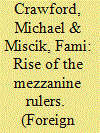

|
|
|
| 17 |
ID:
168568


|
|
|
|
|
| Summary/Abstract |
India's Smart Cities Mission (SCM) launched in 2015 has awarded 100 smart cities nation-wide, proffering funds, compulsory corporate partnerships, and new configurations of urban governance. Perhaps most striking are the ten smart city bids from Northeast India, a region shaped unevenly by separatism, military occupation, and heavy economic dependency. Smart cities in the Northeast have been awarded with key exceptions to SCM rules. We take this to be a largely unprecedented experiment in digital urbanism in what Dunn and Cons (2014. “Aleatory Sovereignty and the Rule of Sensitive Spaces.” Antipode 46 (1): 92–109) label ‘sensitive space’. Through a critical reading of the 10 smart city bids from the Northeast we make three arguments. First, despite the techno-utopian rhetoric, the primary aim of the SCM is integrating frontier space into national territory. Second, the extension of the SCM to the frontier accelerates the recalibration of the frontier into a market for corporate capital under the necessary stewardship of the Indian state, though the role for customary authorities in these arrangements is unclear. Third, with few other avenues for revenue generation and in response to perceptions of neglect, local authorities have used SCM bids to request conventional infrastructure rather than digitally networked projects.
|
|
|
|
|
|
|
|
|
|
|
|
|
|
|
|
| 18 |
ID:
126658
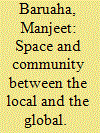

|
|
|
|
|
| Publication |
2013.
|
| Summary/Abstract |
The objective of this article is to situate the relation between the local and the global in the context of a specific region formation, namely the Brahmaputra Valley of Assam in India as a frontier. The article takes up two examples on the relation between space and community construct and how the relation forms part of the deeper relation between the local and the global in the Valley. The Brahmaputra Valley comprises the major area of the Indian state of Assam. Assam and its neighbouring areas are also referred to as 'North East India'. The term came into use during the colonial period. It was used to refer to the British-Indian frontier which bordered on Bhutan, Tibet, China and Myanmar. In the first example of the article, the local-global relation is seen in terms of how the colonial-capitalism paradigm altered the pre-colonial socio-spatial relation, formulating and implementing new spatial and social classifications. The focus in the example is on the rearrangement of socio-spatial relations in the Valley as part of transforming a pre-colonial crossroads into a colonial frontier. In the second example, the relation between space and community construct is situated in popular responses to the above changes, and especially how international ideology like communism is appropriated to address the local specificity of frontier. The works of the cultural icon and peasant leader of the Valley, Bishnu Rabha, are discussed in detail. Through the interrelation between the two examples, the article tries to show how between the nineteenth and the mid-twentieth century the local specificity of the Valley as a frontier was possible precisely due to changes of state formation or ideology which drew on a global context. In other words, the relation between space and community construct in the Valley demonstrates how the coexistence of the local and the global was a necessary condition in its making as a frontier. Community constructs like 'tribe', 'Assamese' and 'Ahom' during the period formed part of this interrelation between the local and the global that
|
|
|
|
|
|
|
|
|
|
|
|
|
|
|
|
| 19 |
ID:
174798


|
|
|
|
|
| Summary/Abstract |
The second half of the nineteenth century was a turning point in the history of modern Manipur when it collaborated with the British in the first Anglo-Burmese War of 1824. With the conclusion of the treaty of Yandaboo 1826, Manipur was transformed into a frontier zone. In this backdrop, the paper explores the pre-colonial notion of territory and how it competed with the European notions of space. Boundaries were fluid, and land was perceived more in terms of people and social relations. The paper also highlights the impact of state formation and territorialisation on identity formation by referring to the changes in the management of the hills and the valley after the 1891 Anglo-Manipuri War. Demarcation of land and boundaries submitted to the logic of rule and control which resulted in the classification of land and people into far more rigid categories like the separate management of the hills and the valley.
|
|
|
|
|
|
|
|
|
|
|
|
|
|
|
|
| 20 |
ID:
169957
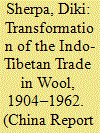

|
|
|
|
|
| Summary/Abstract |
During the first half of the twentieth century, the wool trade articulated new political and economic relationships between Tibet and the British Raj in India and the world beyond. Kalimpong, the Eastern Himalayan town in North Bengal, flourished on the basis of India’s frontier trade with Tibet for about five decades. By placing the trans-frontier wool trade of colonial India at the centre of analysis, this article seeks to highlight the material history that existed on its landed periphery. An attempt will be made to understand the emergence, pattern and significance of India’s trans-frontier trade with Tibet in the light of major geopolitical changes in this region and the world in the twentieth century. The article will argue that the channelling of trade through the Kalimpong–Lhasa route was driven by multiple colonial interests, as well as commercial considerations. In particular, safeguarding the empire and producing a unified sovereign space in the newly established Himalayan frontier constituted a major concern of the British Raj.
|
|
|
|
|
|
|
|
|
|
|
|
|
|
|
|
|
|
|
|
|